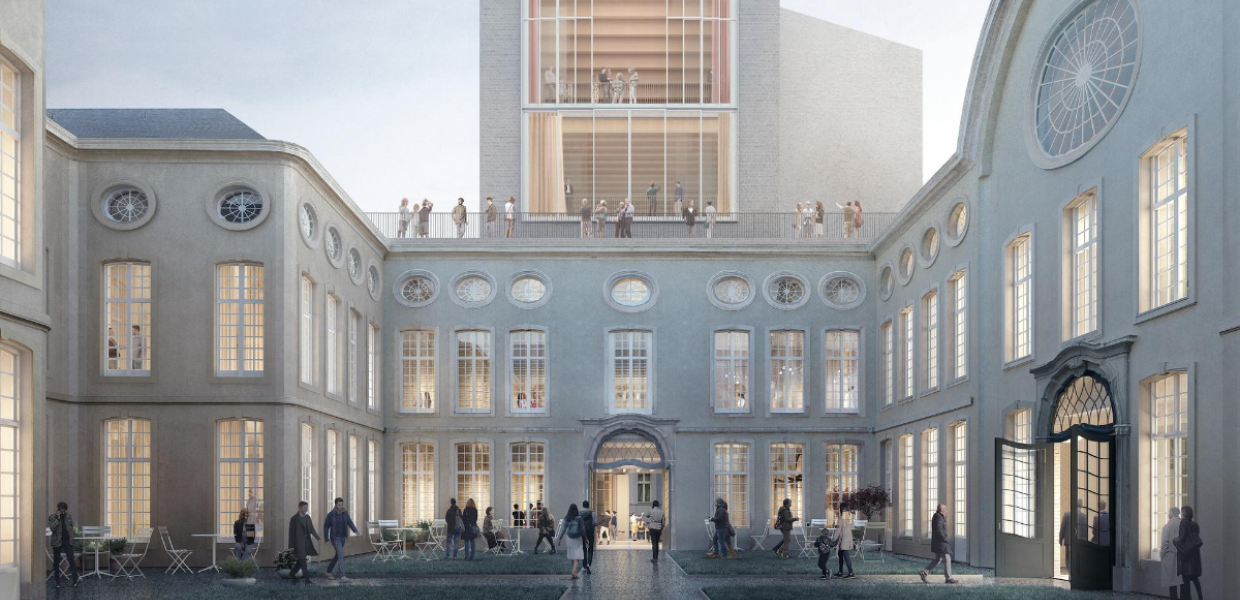Exploring the CoGhent Project
In June, Europeana brought together 60 cultural heritage professionals from across Europe for a special series of peer-to-peer workshops on ‘Digital transformation in the time of COVID-19’. In this post, Jasper Visser - one of the process’s facilitators - interviews participant Oliver D’huynslager of Design Museum Ghent on his experiences in the workshops and the new and exciting ‘CoGhent’ project.

- Title:
- DING Courtyard Open Windows
- Creator:
- Carmody Groarke, TRANS and RE-ST
- Date:
- 9 July 2020
- Copyright:
- CC BY-NC-SA
Together with your colleagues in Ghent, you have been awarded funding for an ambitious project in Europe’s Urban Innovation Actions program: CoGhent. What does the CoGhent project aim to achieve?
Most cities in Europe are digitising their cultural collections, but often lack the tools to leverage this cultural data to engage their citizens. The data is stuck within institutional silos or used on digital platforms which don’t reach out to new audiences because they lack an open infrastructure. One of the main goals of CoGhent is to establish the necessary data architecture and a city-broad data management plan, mainly focused on cultural institutions.
The resulting technology will be given a permanent place in the future wing of the Design Museum Gent named DING. By linking heritage on a city level, using it as a foundation to capture and show stories in cultural spaces, we want to leverage digitised heritage to be used engagingly and purposefully as a shared connection amongst citizens.
CoGhent aims to improve cultural participation and social cohesion through the use of digitised cultural heritage, especially with new audiences. How do you think digital cultural heritage and open data can contribute to improving social cohesion?
The end goal is not merely to open up cultural data; it is about making it useful, usable, and used, about creating Open Knowledge. By offering the tools to crowdsource citizen-stories and citizen-insight on our shared cultural heritage, and making use of linked data to foster cultural diversity and raise its visibility, we hope to increase tolerance for one another and enhance social cohesion.
What are the values underlying CoGhent, and how do you make sure these values are what drive the innovation?
Although the project is very data-driven and tech-heavy, it departs from a set of R&D activities. We will be conducting user-research to figure out which data to open up to our target audience, so hope to have a good understanding of which data could be valuable for both the end-user and museum professional. The challenge in this project is finding the right balance between values-based innovation and also keeping it generic and open enough to transfer to other cities.
This is not your first attempt to use digital tools to make collections more accessible. The project ‘Museum of Things for People’ served a similar goal. How does the Museum of Things project relate to the CoGhent project?
Museum of Things for People had a particular goal; to explore the potential of IoT (Internet of Things) in the gallery space. Making use of ultra-wideband - a radio technology for high precision locating and tracking applications - to track visitor movement, the museum offered visitors recommendations at the end of their visit. However, in order to make these suggestions we were very dependent on mature and linked (open) data. The lack of both internal and external data sources meant the manual input of these recommendations instead of leveraging the capabilities offered through using linked open data, which lies at the heart of the CoGhent project.
You were a participant in Europeana’s sense-making process about digital transformation in the time of COVID-19. What do you think is the impact of COVID-19 on CoGhent and similar initiatives?
Museums gather people to experience art and each other’s perspectives. Until we restore our confidence in public spaces, we need to think about how to come together differently. I firmly believe that COVID-19 will give momentum to similar projects that are in some way trying to develop these new kinds of (digital) spaces. A connection is often made through sharing stories, and that is precisely what we are trying to platform.
Were there any new ideas or approaches you heard about in the workshops which you’d like to explore in your work?
What struck me the most was how we are all becoming very dependent on digital technology and are seemingly forced to change and adapt our practices to its logic. This, however, is a very precarious situation to be in. We need to safeguard our values when moving into this digital domain. When thinking about digital in the museum context I often look for past pivotal moments and ask myself; ‘would we have done any different when we had the same digital tools back then as we have now?’. However digital might be here to stay, I believe that museums don’t need to completely reinvent themselves. Instead, they need to figure out what works for them, both past and future tense, and how technology might elevate on this.
To find out more about this project, please contact Olivier.


